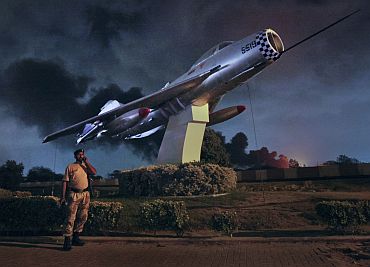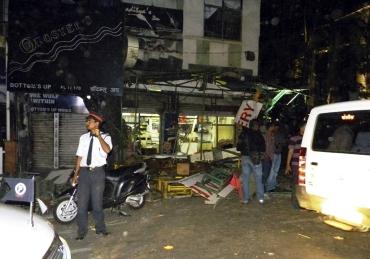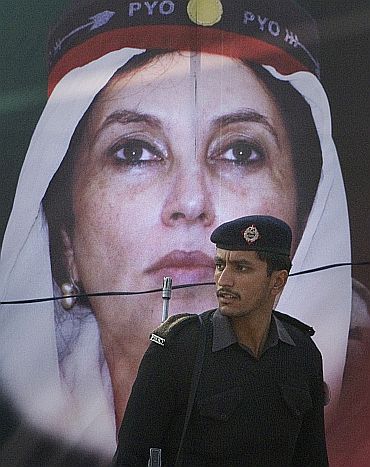 | « Back to article | Print this article |
Why Pak scribe Saleem Shahzad was silenced
The brutal murder of Syed Saleem Shahzad, the Pakistan bureau chief of Asia Times Online, is unlikely to be solved satisfactorily by the investigating agencies of Pakistan.
Shahzad went missing on Sunday evening, while going to the Islamabad studio of a private television news channel and his car with his body was reportedly found at a place about 150 km from Islamabad on Tuesday. His body reportedly had wounds, indicating he had been severely tortured in order to extract information from him.
What was that information? Who was interested in it? The widely believed suspicion in Pakistan is that the information sought to be extracted had a bearing to the first part of a despatch, which he had sent to Asia Times and was carried by it on May 27.
This related to the daring attack by some terrorists on PNS Mehran, the airbase of the Pakistan Navy, at Karachi on the night of May 22 during which the terrorists destroyed two United States-supplied Orion maritime surveillance aircraft which were being used by the navy to patrol the sea to prevent any Al Qaeda attack on ships bringing logistic supplies for the North Atlantic Treaty Organisation forces in Afghanistan.
The responsibility for the attack was claimed by the Tehrik-e-Taliban Pakistan. It said that it carried out the attack to avenge the death of Al Qaeda chief Osama bin Laden.
Click NEXT to read further...
Not Taliban but Al Qaeda behind Mehran attack?
Shahzad did not appear to have believed in the claim of the TTP. His inquiries indicated that the attack was carried out by the 313 Brigade of Ilyas Kashmiri, a former commando of the SSG, which operates from North Waziristan as an affiliate of Al Qaeda.
Shahzad said in the first part of his investigative report: Asia Times Online contacts confirm that the attackers were from Ilyas Kashmiri's 313 Brigade, the operational arm of the Al Qaeda. The Al Qaeda carried out the brazen attack on PNS Mehran naval air station in Karachi on May 22 after talks failed between the navy and Al Qaeda over the release of naval officials arrested on suspicion of Al Qaeda links, he reported.
Kashmiri's 313 Brigade behind German Bakery blast
Subsequently, after the terrorist attack on the German Bakery in Pune in February 2010, Shahzad was in receipt of a message purporting to be from Kashmiri indirectly hinting that the 313 Brigade had a role in the Pune attack. Shahzad had written about it in the Asia Times.
The journalist was thus well informed on the activities of the 313 Brigade and Kashmiri. He was reportedly the only Pakistani journalist with good contacts in the 313 Brigade.'ISI worried that Shahzad would expose their terror links'
It is apparent that Shahzad was killed either because of what he reported in his despatch of May 27 regarding the penetration of the navy by the Al Qaeda or because of what he intended reporting about the training camps of the 313 Brigade.
Thus both the ISI and the 313 Brigade had a common motive for having him eliminated. Was their decision to eliminate him only related to his story on the Mehran attack or was there more to it? Whoever took the decision to eliminate him was in a desperate hurry. He was kidnapped within 48 hours of the first part being published. He would have most probably despatched the second part in the week beginning May 30. His captors wanted to do away with him before that.
'Like Bhutto, Shahzad's death will remain a mystery'
His investigations post-May 2 were dangerously moving in that direction. His discovery of the penetration of the navy by the Al Qaeda was only the first step in his investigation. According to these police sources, he was digging deeper into bin Laden's support base.
To have waited till he found out the details would have been suicidal for the ISI. The police sources suspect that the ISI joined hands with the 313 Brigade to eliminate him before he made any progress in the matter.
The "real" truth will never be known just as the "real" truth behind the murder of Murtaza Bhutto in Karachi in 1996 and behind the murder of Benazir Bhutto at Rawalpindi in 2007 was never known.
People will be arrested and prosecuted, but they will not be the real perpetrators. The history of Pakistan is full of such instances of mysterious elimination of inconvenient people.
Shahzad is the latest to join the ranks of such mysteriously eliminated people. He has paid with his life for daring to look into two incidents, which the ISI wanted to be covered up -- the Mehran attack and the stay of OBL at Abbottabad.



